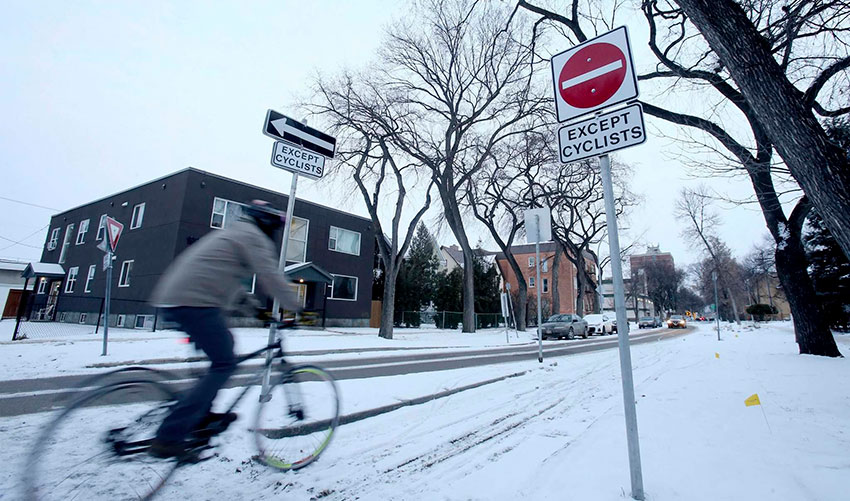
By Brent Bellamy, Architect + Creative Director
Originally published in the Winnipeg Free Press
In our desperate battle to slow the spread of the coronavirus, almost four billion people, half the world’s population, are living under stay-at-home orders. In a rare united effort, governments, industry and citizens alike are working together to combat a common global enemy. The scale and speed of societal change left in its wake would have been unthinkable only a few weeks ago.

(SHANNON VANRAES / WINNIPEG FREE PRESS FILES) Active transportation can play a key role, both during the pandemic and in rebuilding the city’s physical and social infrastructure afterward.
As we move through and out of this fight, the power of this new social cohesion presents us with an opportunity to boldly rebuild a country that is more economically resilient, environmentally sustainable, socially just and physically healthier. Cities will be at the front lines of this opportunity, and re-thinking the way we move around them will be fundamental to these goals.
We have suddenly learned the importance of physical distancing, and with more people out walking, we are also learning how little pedestrian space there actually is in our cities. Across the world, streets are being closed to cars, as cities scramble to create temporary public space for people to access sunlight and fresh air while maintaining safe distances from each other.
As the increased need for easily accessible space to walk and ride a bike becomes more permanent, so will these solutions.
With everyone at home, increased pedestrian and cycling space is important for exercise and public health, but as time goes on, it will become increasingly vital for connectivity, to access employment, education and recreation. The coronavirus pandemic will likely have long-term impacts on transit use, and we must find a way to replace that mobility.
In Winnipeg, people take a combined 170,000 trips every day on the bus. The social, environmental and economic impact of losing any part of that could be devastating. Creating infrastructure that allows people to safely walk and bike to access their daily needs can be a big part of the response.
Winnipeg is well prepared to quickly implement a bold new mobility plan. The city’s 20-year Pedestrian and Cycling Strategy provides a visionary blueprint which, if implemented, would respond to many of our immediate needs, and make Winnipeg an active-transportation leader in North America as we move forward.
The design includes 80 kilometres of protected bike lanes crossing every neighbourhood in the city, including a 13-lane downtown grid, as well as hundreds of kilometres of new sidewalks, sidewalk widening and renewal, and off-street pathways.
The plan also includes several active transportation bridges. With typical construction costs being 80 to 90 per cent less than a vehicle bridge, they could affordably introduce a new network of connectivity between Winnipeg’s divided neighbourhoods. Strategically located bridges could provide easy walking and cycling access to greenspace between communities — for example, connecting St. Vital Park to Pembina Highway, or Kildonan Park to Henderson Highway.
These bridges and other active-transportation infrastructure could provide critical support for small business, helping to build resilient neighbourhood economies by reducing pedestrian distances and expanding the potential market for the local shops, restaurants and services being devastated in the current shut down.
With well-located pedestrian bridges, shops on Wolseley’s Westminster Avenue could be a nine-minute walk from the shops on Academy Road, the Osborne strip could be a seven-minute walk from Norwood Flats, or a 10-minute walk to the restaurants on Sherbrook Street.
The estimated cost to build the entire 20-year plan is pegged at $330 million, which sounds daunting, but within the scope of current and future federal stimulus initiatives, doing it all at once is bold but not unrealistic. Rebuilding our economy after the pandemic will be critical, and active transportation construction has proven to be one of the best infrastructure investments possible, in terms of job creation and economic return.
A comprehensive study at the University of Massachusetts showed that because they use more labour and fewer materials, and the materials they do use are more often locally produced, bicycle infrastructure projects can create up to 11.4 jobs for every $1 million invested — 46 per cent more than car-only road projects, with pedestrian-only projects falling somewhere inbetween.
A comprehensive active-transportation network could be implemented quickly on a temporary basis, following the Pedestrian and Cycling Strategy, and then transitioned to permanent as the pandemic slows and economic stimulus is prioritized.
Almost every city in the world that has built active-transportation infrastructure has seen a dramatic increase in use, including through the winter months. In the short term, these networks could provide appropriate space for social distancing, and in the future, increased participation would help build a more resilient society.
Reduced driving would lower greenhouse-gas emissions and air pollution, a potential carrier of airborne viruses, and improve physical health, which can strengthen immune systems and reduce pre-existing conditions.
With more people in the streets, a concurrent initiative to provide immediate help would be to implement a city-wide pilot project to reduce speed limits on residential streets to 30 km/h, something already being considered at city hall. Slower speeds significantly reduce the number of vehicle collisions and injury severity. In Manitoba alone, seven people every day on average are sent to hospital because of vehicle collisions. Now more than ever, we should be working to reduce the number of people taking space in our hospitals.
The coronavirus pandemic is a stark warning that we are part of a delicate, interwoven ecosystem, and if we push it too hard, it breaks. Our response requires both immediate solutions, and preparation for a long fight. We must also consider future pandemics and, most importantly, this must be a wake-up call to finally address the looming climate crisis, before it becomes a similar global emergency.
Governments can work together now to make active transportation an important part of the solution across Canada, helping to get us through this crisis today and helping to meet our economic, environmental and public-health needs in the world we build when it is over.
Brent Bellamy is creative director at Number TEN Architectural Group.

